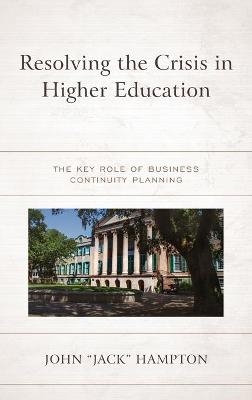
Resolving the Crisis in Higher Education
Rowman & Littlefield (Verlag)
978-1-4758-6167-9 (ISBN)
John “Jack” Hampton is a professor at St. Peter’s University and a former dean of the schools of business at Seton Hall and Connecticut State universities. He is the author of multiple enterprise risk management books with the American Management Association and a series of higher education books with Rowman & Littlefield.
List of Figures
Preface
Chapter 1. Do Liberal Arts Colleges Have Viable Business Models? Even More Important, Why Do They Need Them?
The Liberal Arts
Liberal Arts Foundation
Disagreement on Achieving the Outcomes
Comparing a Liberal Arts Lecture and a Typewriter
Mission, Vision, and Values Statements
Key Terms
A Simple Business Model and Value Chain
Business Model for a University
Value Chain for a Calligraphy Degree
Faculty View of a Value Chain
Administrator View of a Value Chain
Chapter 2. What is the Risk of a Faulty Business Model? Do Professors and Administrators Need to Work Together to Get it Right?
Strategy and Tactics
Strategic Purpose
Components of a Value Chain
Design Thinking is Recommended
Issues When Developing a Value Chain
Three Determinants of Value
Risk Factors in Value Chains
Market Insights in Value Chains
Strategies of a Business Model
Customer-based Business Model
Chapter 3. Does Your University Know about Enterprise Risk Management (ERM)? Or Will Risks Simply Take Care of Themselves?
Enterprise Risk Management
Business Risk
Addressing Business Risk
Questions about ERM
Categorizing Risk
Chapter 4. Why is Managing the Business Model Similar to Climbing Mount Everest? Are We Sure We Know What We’re Doing as We Face Risk in the Immediate Future?
Would you Consider Climbing Mount Everest?
Should a University Accept the Risks of Changing its Business Model?
The Risk Picture for Universities
Evaluating Risk
Managing Risk in the Business Model
Institutional Category
Financial Health
Chapter 5. How Does a University Revise its Business Model? Are We Getting into the World of Business Continuity Planning?
Business Continuity
Business Continuity Planning (BCP) Task Force
Bureaucratic Team
Innovative Team
Chapter 6. Where Does the Liberal Arts Fit in a Sustainable Value Chain for a University? Does Anybody Really Care about Shakespeare?
A Focus On Our Students
What Do Our Students Want?
What Do Our Students Need?
Does the Traditional College Model Support Critical Thinking?
Liberal Arts Core Outcomes
Bachelor Degree Outcomes
Liberal Arts Core Courses
Chapter 7. Business Continuity Planning (BCP) on a Liberal Arts Foundation: What Do We Have to Consider? What Do We Have to Change?
Business Model and Philosophy
Value Chain Analysis—Student Component
What Factors Shape Student Choices of Colleges?
What Factors Motivate Students to Attend College?
Academic Motives for Attending College
Chapter 8. Let’s Build a Modern Curriculum on a Liberal Arts Foundation: Hey, This Is A Program that Really Meets My Needs
Curriculum Design
Design of a College Program
College Course Formats
Flexible Formats of Courses
Evaluation of Student Performance
Chapter 9. Let’s Build our Own Undergraduate Degree on a Liberal Arts Foundation: If We Design and Offer the Right Products, Will They Come?
A Unique College Experience
Recruiting Message
Admission Requirement
Graduation Flexibility
Course Formats
Competitive Tuition
Course Schedule
Courses and Curriculums
Bachelor’s Degree in Liberal Arts or Business Administration
Two Bachelor’s Degrees
Transfer Students
Flexible Formats and Grading for Courses
Chapter 10. Authority, Responsibility, and Accountability in Business Continuity Planning: Who Should Be Responsible for What?
Curriculum Discussions
Board of Trustees Responsibilities
Responsibilities of the University Officers
BS in Liberal Arts Major
Information Acquisition 101
Cause and Effect 101
Interpretation of Written Meaning 101
Numerical Literacy 101
Personal Perspectives 101
Visual Language 101
Thinking in Time 101
Argumentation 101
Business Administration Major Outcomes
Business Continuity Plan for the MBA
MBA Course Formats
MBA Marketing Effort
Chapter 11. End of the Journey: What Would Happen if No One Listens to the Crisis in Higher Education?
Framework of Risk and Uncertainty
Evaluating Business Continuity Efforts
A Final Thought
| Erscheinungsdatum | 04.06.2021 |
|---|---|
| Verlagsort | Lanham, MD |
| Sprache | englisch |
| Maße | 162 x 229 mm |
| Gewicht | 376 g |
| Themenwelt | Studium ► Querschnittsbereiche ► Infektiologie / Immunologie |
| Sozialwissenschaften ► Pädagogik ► Erwachsenenbildung | |
| ISBN-10 | 1-4758-6167-2 / 1475861672 |
| ISBN-13 | 978-1-4758-6167-9 / 9781475861679 |
| Zustand | Neuware |
| Haben Sie eine Frage zum Produkt? |
aus dem Bereich


